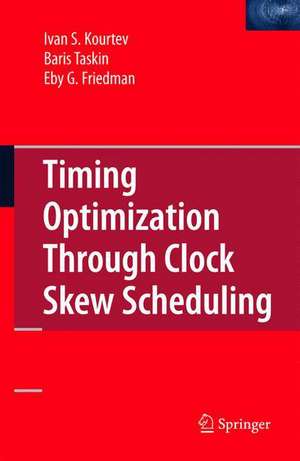Timing Optimization Through Clock Skew Scheduling
Autor Ivan S. Kourtev, Baris Taskin, Eby G. Friedmanen Limba Engleză Hardback – 21 noi 2008
| Toate formatele și edițiile | Preț | Express |
|---|---|---|
| Paperback (2) | 636.80 lei 43-57 zile | |
| Springer Us – 3 oct 2012 | 636.80 lei 43-57 zile | |
| Springer Us – 4 noi 2010 | 639.73 lei 43-57 zile | |
| Hardback (2) | 643.00 lei 43-57 zile | |
| Springer Us – 31 mar 2000 | 643.00 lei 43-57 zile | |
| Springer Us – 21 noi 2008 | 646.11 lei 43-57 zile |
Preț: 646.11 lei
Preț vechi: 760.13 lei
-15% Nou
Puncte Express: 969
Preț estimativ în valută:
123.65€ • 128.61$ • 102.08£
123.65€ • 128.61$ • 102.08£
Carte tipărită la comandă
Livrare economică 14-28 aprilie
Preluare comenzi: 021 569.72.76
Specificații
ISBN-13: 9780387710556
ISBN-10: 0387710558
Pagini: 266
Ilustrații: XVI, 266 p.
Dimensiuni: 155 x 235 x 18 mm
Greutate: 0.58 kg
Ediția:2009
Editura: Springer Us
Colecția Springer
Locul publicării:New York, NY, United States
ISBN-10: 0387710558
Pagini: 266
Ilustrații: XVI, 266 p.
Dimensiuni: 155 x 235 x 18 mm
Greutate: 0.58 kg
Ediția:2009
Editura: Springer Us
Colecția Springer
Locul publicării:New York, NY, United States
Public țintă
ResearchCuprins
VLSI Systems.- Signal Delay in VLSI Systems.- Timing Properties of Synchronous Systems.- Clock Skew Scheduling and Clock Tree Synthesis.- Clock Skew Scheduling of Level-Sensitive Circuits.- Clock Skew Scheduling for Improved Reliability.- Delay Insertion and Clock Skew Scheduling.- Practical Considerations.- Clock Skew Scheduling in Rotary Clocking Technology.- Experimental Results.
Textul de pe ultima copertă
Timing Optimization Through Clock Skew Scheduling focuses on optimizing the timing of large scale, high performance, digital synchronous systems. A particular emphasis is placed on algorithms for non-zero clock skew scheduling to improve the performance and reliability of VLSI circuits.
This research monograph answers the need for a broad introduction to state-of-the-art clock skew scheduling algorithms from a circuit, graph, and mathematical optimization background. A detailed description of clock skew scheduling application on edge-triggered and level-sensitive circuits, synchronized with single and multi-phase clocking schemes, and formulated as linear programming (LP) and quadratic programming (QP) formulations are provided along with an analysis of optimal computer solution techniques. Theoretical limits of improvement in clock frequency through clock skew scheduling are highlighted. Hints and a preliminary implementation of a parallel skew scheduling application are also included.
Timing Optimization Through Clock Skew Scheduling contains sufficient detail for the advanced CAD algorithm developer, researcher and graduate student. Furthermore, with the material provided on timing properties and optimization, those readers with less background can also benefit from this book.
This research monograph answers the need for a broad introduction to state-of-the-art clock skew scheduling algorithms from a circuit, graph, and mathematical optimization background. A detailed description of clock skew scheduling application on edge-triggered and level-sensitive circuits, synchronized with single and multi-phase clocking schemes, and formulated as linear programming (LP) and quadratic programming (QP) formulations are provided along with an analysis of optimal computer solution techniques. Theoretical limits of improvement in clock frequency through clock skew scheduling are highlighted. Hints and a preliminary implementation of a parallel skew scheduling application are also included.
Timing Optimization Through Clock Skew Scheduling contains sufficient detail for the advanced CAD algorithm developer, researcher and graduate student. Furthermore, with the material provided on timing properties and optimization, those readers with less background can also benefit from this book.
Caracteristici
Focuses on timing analysis and optimization techniques for circuits with level-sensitive memory elements Contains a linear programming formulation applicable to the timing analysis of large scale circuits Includes a delay insertion methodology that improves the efficiency of clock skew scheduling in level-sensitive circuits Provides an overview of circuit partitioning, placement, and synchronization methodologies that enables the implementation of high speed, low power circuits synchronized with ultra-modern resonant clocking technology Provides a framework for and results from implementing the described timing optimization algorithms in a parallel computing environment












